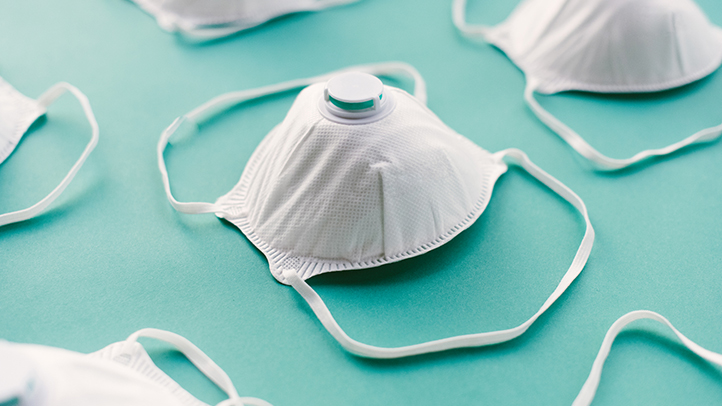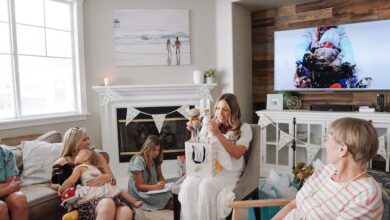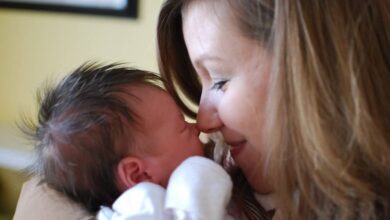COVID-19 Face Mask Guidelines for Babies & Toddlers

To prevent the spread of COVID-19, the Centers for Disease Control and Prevention (CDC) recommends that all people age 2 and older wear a face mask in public places indoors if they have not been fully vaccinated. In addition, fully vaccinated people can maximize their protection by wearing masks inside public places in areas with high prevalence of COVID-19.
If you are a parent of a child, especially if you have a baby under 6 months old who has not yet been vaccinated, the CDC recommendation may raise some questions, such as: Why can’t face masks be worn? children under 2 years old? And how are babies supposed to stay safe in public settings without a mask?
Why shouldn’t babies wear face masks?
If your child is under 2 years old, the CDC says he shouldn’t wear a face mask, in part because he may have trouble breathing through one.
Babies and younger children have smaller airways and cannot speak if they cannot breathe properly. “If they’re having trouble breathing while wearing a mask, they can’t tell you they’re having trouble breathing,” says Patricia Garcia, MD, a pediatrician at Connecticut Children’s hospital.
Some masks can also pose a choking hazard, says Ashanti Woods, MD, a pediatrician at Baltimore’s Mercy Medical Center. For example, the strings on some face masks can be dangerous for babies.
Furthermore, many infants and young children under the age of 2 are likely to try to remove a mask if one is worn.
Toddlers past their second birthday can safely wear face masks. Need some ideas? Here are some of our favorite masks for kids ages 2 and up.
How should babies and toddlers stay safe in public places?
In an ideal world, if you live in an area with a high prevalence of COVID-19, you would keep your child away from public places like the grocery store or pharmacy.
“The best option is to avoid taking your kids anywhere that’s crowded,” says Dr. Garcia.
But of course, this is often not possible. If you must take your child out in public, experts say it’s a good idea to take the following precautions:
- Put your baby on. If your child is still old enough to fit in a baby carrier, face him toward you and try to keep him close to your body, says Dr. Woods.
- Carry your baby in his car seat with a cover. It can be overwhelming to tote your child in their seat, but covering the car seat with a breathable cloth can help, says Julia Sammons, MD, medical director of the Department of Infection Prevention and Control at Children’s Hospital of Philadelphia.
- Push your child in his stroller with a cover. If you have a plastic rain cover for your stroller, Dr. Woods that’s a good option. Otherwise, a breathable fabric can also work.
- Lower your stroller awning. If you don’t have a stroller cover or forgot a cover, putting an awning on your stroller is better than nothing, says Daniel S. Ganjian, MD, FAAP, a pediatrician at Providence Saint John’s Health Center in Santa Monica, California. .
- Children will be vaccinated when they are eligible. Babies 6 months and older are now eligible to get the COVID-19 vaccine. Vaccines are safe for children, side effects are usually mild and short-term, and vaccination can help lower the risk of serious illness or hospitalization.
What types of face masks should children 2 and older wear?
The CDC recommends that children 2 and older wear face masks, specifically one that meets these guidelines:
- Goes over the nose and under the chin
- Fits perfectly on the side of the face and has no gaps
When it comes to different types of masks, the CDC says that suitable disposable surgical masks, KN95 and N95 offer more protection than cloth masks, but the best type of mask is the one worn by your child correctly. A cloth mask made of multiple layers of tightly woven, breathable fabric and a nose wire will still offer protection against COVID-19.
Of course, even with the right mask on hand, it can be difficult to get your child to wear it. Giving your child ownership of their mask can help, says Ganjian. “Get a cloth mask that they can color or that has a design they like,” she says.
Additionally, you can get your child a mask that matches yours and talk about how you are a team. “You can also have an incentive afterwards,” says Dr. Ganjian.
Was this article helpful?





